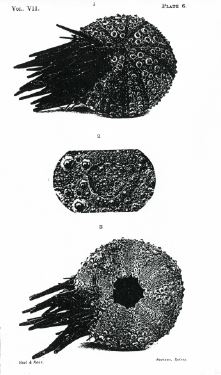page 93
ON A NEW SPECIES OF STOMOPNEUSTES AND A NEW VARIETY OF HIPPONOE VARIEGATA.
By THE REV. J. E. TENISON-WOODS, F.G.S., F.L.S., &c.
[Plates VI. and VII.]
Hitherto there has been only one species of Stomopneustes known, and I formerly believed our Australian species to be identical with it. Under this impression I classified the only specimen I had ever seen as Stomtopneustes variolaris, Laniark. See Proceedings Linnean Society, N. S. Wales, Vol. 2 (1877-78), p. 156. In Vol. 5 of the same Proceedings I gave my reasons for regarding the species as distinct (see p. 198), and distinguished it by the name of S. atrapurpurea. I there stated that it is very common on the N.E. coast within the tropics. I now figure the species and give the following diagnosis:-
STOMOPNEUSTES ATRAPURPUREA., n.s., Plate 6.
Test circular or obscurely pentangular, in large and old specimens eccentric, of a pale brownish pink color with darker purple stains. Poriferous zone slightly undulating, rather narrow, the inner or third row on each line separated by a line of secondary tubercles. Ambulacral and interambulacral areas thickly covered with primary, secondary, and. miliary tubercles, the latter arranged in rings around the primaries. Ambulacral area with two rows of primary tubercles, bordered on each side by a row of secondaries, which alternate in size, being larger when they are opposite spaces between the primaries, and smaller when they are beside them. In the middle of the area there is a deep undulating groove bordered by a line of miliaries. This groove is continuous from the anal system to the actinosome. Interambulacral area with two rows of primary tubercles with irregularly scattered secondaries, the primaries being slightly smaller than those of the A. areas. Mammary bosses hemispherical
page 94
and somewhat depressed, enamelled. Scrobicular area large, elevated. Actinal surface flattening suddenly and conspicuously from the ambitus, and the tubercles thereon nearly uniform and gradually diminishing in size and number to the actinosome, which is of medium size, with the notches broad and rather deep. Auricles small, arch complete with a square summit and a somewhat oval or perfectly round foramen. Lantern tall, arches stout, and solid, teeth narrow, rather long, acute. Anal system small pentagonal. Genital plates, large, irregularly quadrate, with the pore large, subcentral or a tendency towards the outer edge. Ocular plates small subquadrate. Both kind of plates with secondary and miliary tubercles. Madreporic body large, somewhat elevated, broadly heart-shaped, pore quite on the outer edge, with scattered miliaries. Inner plates numerous, decreasing in size to an eccentric depression. Spines numerous: of almost black purple color, blunt, slender, but somewhat swollen in the centre, very finely grooved longitudinally. Miliary ring conspicuous but of uniform color. The secondary and miliary spines cylindrical.
The differences between this species and S. variolaris are: 1. The size, it being twice and a half times larger. 2. The color. 3. The disposition of the tubercles. 4. The size of the anal system. 5. The form of the genital, ocular, and madreform plates. 6. Actinal cuts. 7. The groove, which is less waved. I have in this diagnosis marked the special differences in italics. In page 198, Vol. v., Lin. Soc. N. S. Wales Proc., the specific name is misspelt atropurpurea.
HIPPONOE VARIEGATA, Leske, var. alba nobis, Plate 7.
I here figure a small and very interesting variety of this most variable species, in which the spines are small and slender, and the color white, with the test a rose pink. Usually in the tropics the color is pale violet almost approaching blue. In Sydney, if we are to regard the species as the same, the size is very much larger, and the test a deep purple brown.
Plate 6.

Plate 7.
